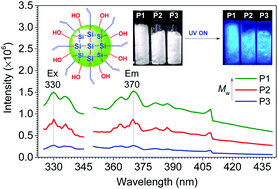Unanticipated bright blue fluorescence produced from novel hyperbranched polysiloxanes carrying unconjugated carbon–carbon double bonds and hydroxyl groups†
Abstract
One-pot polycondensation reaction of triethoxyvinylsilane (A-151) with excessive neopentyl glycol (NPG) is employed as an efficient and facile methodology for the synthesis of novel hyperbranched polysiloxanes contemporaneously bearing plenty of unconjugated carbon–carbon double bonds and hydroxyl groups (HPUHs). Interestingly, the obtained HPUHs obviously without containing conventional chromophores exhibit conspicuous ultraviolet absorbency and bright blue photoluminescence when irradiated by a UV lamp with 365 nm wavelength. The excitation and emission intensities of the as-prepared polymers progressively grow along with raising their molecular weights and concentrations, and even the brightest blue glow in the solid state is observed, suggesting the emission intensity is molecular-weight and concentration-dependent. The preliminary investigation indicates that both the carbon–carbon double bond and the hydroxyl group are very important in the formation of blue-luminescent species. Thus, this work opens a new route to design new light-emitting materials.

- This article is part of the themed collection: Advisory Board’s top picks from Polymer Chemistry

 Please wait while we load your content...
Please wait while we load your content...